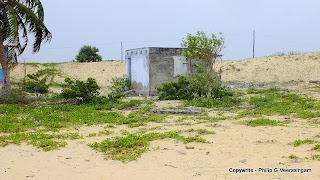 |
| Houses destroyed by the Tsunami. |
 |
| New buildings close to the beach. |
The fury of the Tsunami which wiped out the residents close to the beach. Similar occurrences are recorded in tales and legends going back more than two millenia. The shorelines facing the eastern parts of the Island and of the Indian sub-continent have these tales. Prosperous trade emporia like Vallipuram in Sri Lanka and Kaverippooom Pattinam in South India were wiped out in a matter of minutes. Indra was the God of the Oceans and the destruction of Kaverippoom Pattinum in South India was attributed by the populace, to a failure to hold the annual festivities - called Indra Villaa - to this God. This is related in the Tamil Buddhist epic 'Manimekalai' written about the 2nd Century AD.


























